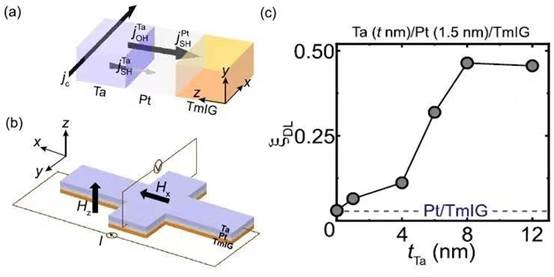It has long been believed that the attachment of two heavy metals such as Ta and Pt with opposite spin Hall angles results in a weakened net torque generation efficiency in magnetization switching devices. Recently, Associate Prof. An Hongyu from College of New Materials and New Energies at Shenzhen Technology University (SZTU) and his research team reported a giant orbital-to-spin conversion in Ta/Pt/Tm3Fe5O12 (TmIG) heterostructures.
The research shows that the torque generation efficiency is enhanced by an order of magnitude in the Ta/Pt/TmIG trilayer compared to that in the Pt/TmIG bilayer. This enhancement is further evidenced by the fact that the critical current density for the magnetization switching of the Ta/Pt/TmIG is an order of magnitude smaller than that of the Pt/TmIG. It is found that the orbital current generated from Ta through the orbital Hall effect (OHE) is converted to the spin current in the interior of Pt.

(a) Schematic of the generation and transport of the spin current jSH and orbital current jSH in the Ta/Pt/TmIG heterostructure; (b) Schematic of the setup for the AHE resistance measurement; (c) Ta thickness dependence of the effective torque generation efficiency ξDL [Photo/https://pubs.acs.org/doi/10.1021/acs.nanolett.3c02104]
The discovery offers an extraordinary approach to enhance the torque generation for magnetization switching of insulators and provides an important piece of information for orbitronics.

Current-induced magnetization switching curves [Photo/https://pubs.acs.org/doi/10.1021/acs.nanolett.3c02104]
The research team published an article titled “Giant Orbital-to-Spin Conversion for Efficient Current-Induced Magnetization Switching of Ferrimagnetic Insulator” in Nano Letters, a leading journal in the field of nanomaterials. Li Tianhui, postgraduate student from College of New Materials and New Energies at SZTU is the first author. Associate Prof. An Hongyu and Associate Prof. Kazuya Ando from Keio University are co-corresponding authors. SZTU is the first affiliation. The full text of the article can be found at: https://pubs.acs.org/doi/10.1021/acs.nanolett.3c02104.
Drafted by Christine(黄昭萱)/ International Cooperation & Student Affairs Office
Revised by International Cooperation & Student Affairs Office
Edited by International Cooperation & Student Affairs Office
